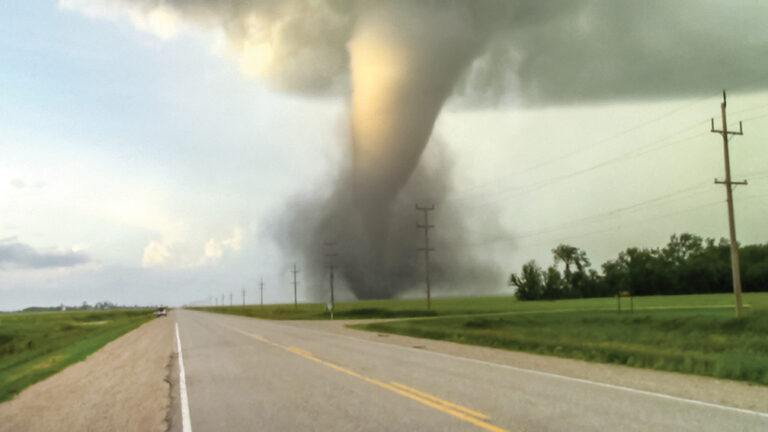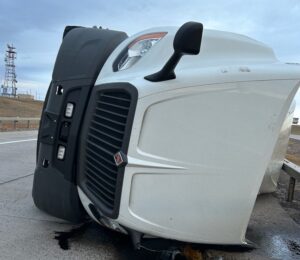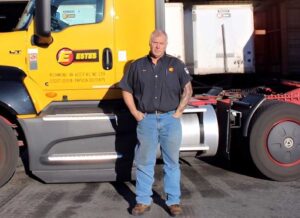There’s not much on the topic of tornadoes that Emory Mills doesn’t know. As safety director for Oklahoma City-based FTC Transportation, she’s spent nearly two decades plying her trade in the heart of Tornado Alley.
This region of the U.S., which includes Oklahoma, Texas, Kansas, Nebraska, South Dakota and parts of many adjoining states, sees the highest number of tornadoes in the world.
It’s the kind of real-world proving ground that has turned Mills into an expert on surviving twisters — and it shows. Despite the company’s location, FTC has never suffered a loss of life among its employees due to a weather event.
Mills says consistent communication is one big reason for this.
“We do have an orientation, and we try to cover all of the different safety aspects (in it),” she said. “We do monthly newsletters, so when we move into springtime, we make sure that information is out there — even though tornadoes aren’t just in springtime; they come year-round in this area.”
Mills’ description of the frequency of tornados isn’t just anecdotal. There were 1,376 confirmed tornadoes in the U.S. last year according to Statista.com. That’s the third-highest number in any given year over the past decade — despite the fact that the usual “tornado season” months showed lighter than normal activity. April, for instance, had the fewest tornados since 1992; June had the fifth-lowest outbreak on record; and 2021 boasted the first May in history to not have a tornado rating an F3 or higher.
However, October and December 2021 had the most twisters on record — 146 and 222, respectively — ranging from the relatively innocuous F0 (65-85 mph winds) to the much more severe F3 (136-165 mph). This odd pattern of occurrences underscores the need for constant reiteration of safety protocols, even among experienced drivers.
“We have a pretty seasoned crew, for the most part,” Mills said. “We do ongoing training on different safety practices whether it’s weather-related, equipment-related, traffic — whatever it may be.
“Those are just refreshers, but even our most seasoned drivers sometimes tell me, ‘You know what? I learned something I didn’t know,’” she continued. “We all need refreshers and reminders, because everybody gets complacent or forgetful.”
Technology has also come to play a major role in keeping drivers safe while out on the road during stormy weather.
“Carriers should be sending information to drivers along the way — sending warnings and instructing people to reroute,” said Jane Jazrawy, co-founder and CEO of Ontario-based CarriersEdge.
“You should also give the drivers their own access to weather information or tell them how to find it using traditional methods with a browser,” she said. “Even if you don’t have any fancy technology, (that knowledge is) going to help the driver find out for themselves what’s going on around them.”
Technology isn’t the “be-all and end-all” when it comes to driver safety, Jazrawy said. Companies need to have a plan that outlines various scenarios and informs their drivers on what the company expects them to do in these situations.
“In order for the driver to be prepared for this kind of thing — especially when they’re not used to it — as a carrier you want to have a plan,” Jazrawy said. “There should be a plan that the carrier communicates to the driver on what they’re expected to do and what parameters they are working with, especially if they haven’t been in the situation before.”
For example, Jazrawy said, just knowing the difference between a tornado “watch” and a tornado “warning” can help a driver avert a catastrophic situation.
Per the National Weather Service, a tornado watch means conditions are favorable for the development of severe thunderstorms and tornadoes in and around the “watch” area. A tornado warning, on the other hand, means a developing tornado has been detected by National Weather Service Doppler Radar or has been reported on the ground by reliable sources. The latter bulletin should alert people to take shelter immediately.
“Carriers often don’t have plans; they just assume that the driver knows what to do,” Jazrawy said. “Even if it’s something that you think you’ve lived through and you know about, you have to tell people what to expect, what it looks like and what to do.”
The same attention should be paid to informing drivers what to do when confronted with these dangerous weather situations. Personal safety should always be stressed over the safety of the equipment, meaning drivers have to know the plan when weather conditions around them deteriorate.
“The truck is absolutely NOT the first place of shelter,” Mills said.
“Neither is parking under an overpass or going to a ditch. People think if they get out of their vehicle and hit the ditch, ‘I’m safe, I’m in a ditch, I’m low-lying,’ only to be injured by flying debris,” she explained. “It’s not a matter of being sucked up by the tornado; it’s a matter of the debris that’s flying about.”
Drivers who find themselves impacted by a tornado warning while on the highway often find it hard to find shelter.
“Obviously, we would rather drivers be in an underground shelter of some sort or a safe room, but not all truck stops are equipped with that,” Mills said. “At the very least, if they can get to a rest area, a truck stop, something that has some sort of building structure where they can get to the centermost part away from windows. But basically, get away from the truck.”
A good company tornado action plan will also educate drivers about what to do after the storm has passed, from checking in to convey their personal status as well as that of their truck to receiving further bulletins on what to do next.
Katie Griffin, director of fleet safety with Leonard’s Express in Farmington, New York, says that after the storm passes and the driver’s well-being has been confirmed, the plan should swing into a different mode to help resume service.
“First off, our account management team will relay the information to our customers to let them know that there will be delays. Customers, of course, are understanding,” Griffin said.
“The account management team works out the next delivery date and time,” she continued. “Then we coordinate to route other drivers to relay and pick up the trailer to get the delivery made or determine if we’re able to get the driver that was originally on the load to deliver at a different time.”
This type of detailed preparedness is one reason Griffin’s team was just announced as the winner of the 2021 Trucking Association Safety Council Fleet Safety Award, presented by the Trucking Association of New York.
“We continually convey the message, ‘Driver safety comes first,’” Griffin said. “Drivers communicate with our office about where they’re at, and we can often reroute them to avoid bad situations. If that’s not possible and they’re running into bad weather, they know they are to park it.”
Dwain Hebda is a freelance journalist, author, editor and storyteller in Little Rock, Arkansas. In addition to The Trucker, his work appears in more than 35 publications across multiple states each year. Hebda’s writing has been awarded by the Society of Professional Journalists and a Finalist in Best Of Arkansas rankings by AY Magazine. He is president of Ya!Mule Wordsmiths, which provides editorial services to publications and companies.















Very informative and being a truck driver from Nebraska it is enlighting to see company’s take Tornado and Blizzard or any weather related issues safety for the Truck drivers seriously and for the care of the drivers and all involved. This Practice saves lives and pre planning is the best practice. Makes it enjoyable to work with these companies and for the comfort of the Drivers and there Family’s. Thank You for the Article and helping the Truckers Awareness as The Tornado Alley is nothing to play with We Know God Bless rick Claussen Neligh Ne.🎚🇺🇸👋🏻🤠🙏
I can attest to Emory Mills stance on Safety First as she is my Safety Director. We receive timely communication regarding all matters relating to safety and safe conduct with periodic online training sessions. She is instrumental in our success as a team.